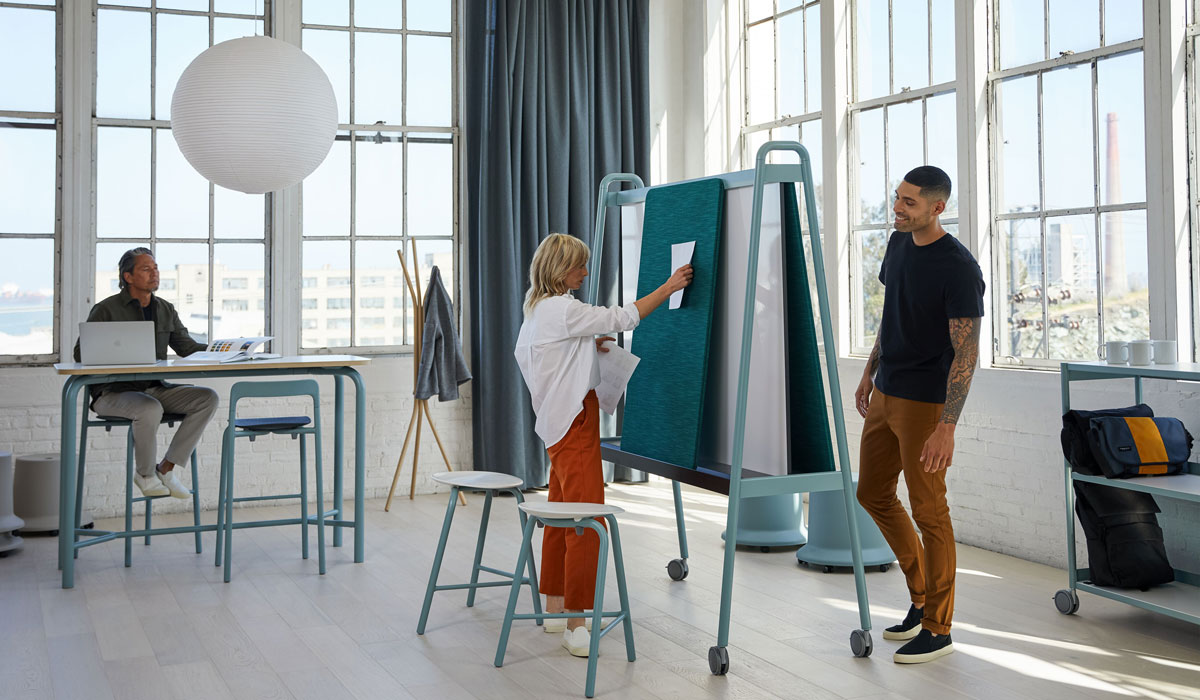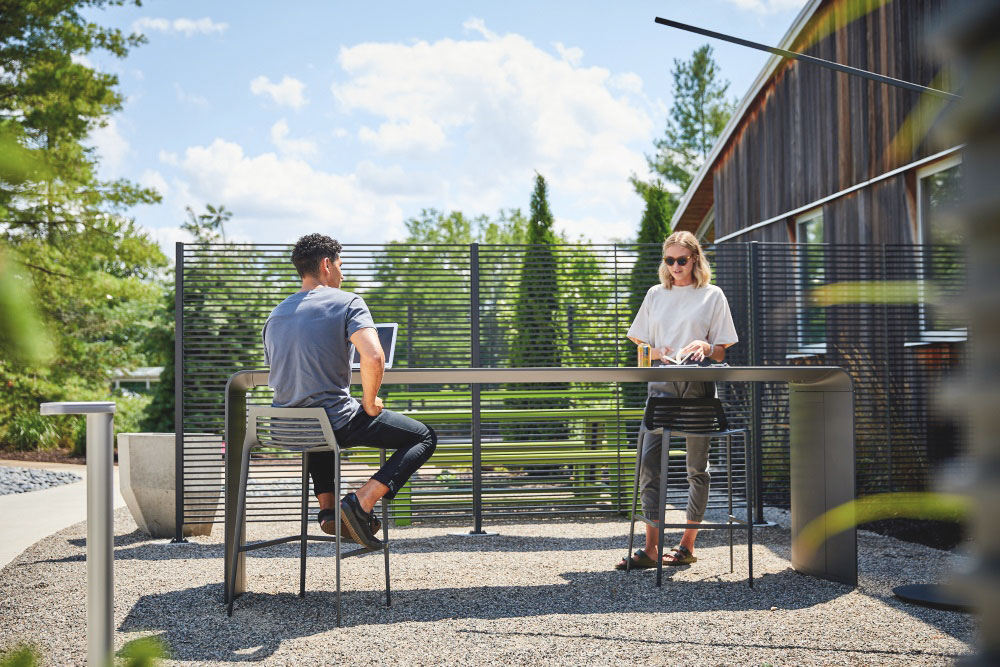What’s Next for Workplace Design: Balancing Personal Space & the Need for Collaboration

Image courtesy Teknion – Teknion.com
As humans, we need to connect with each other – and not merely on a screen. While remote work has offered a variety of benefits, we are seeing strong indicators that people want to get back to the office – as long as it feels safe and there is no loss of newfound flexibility. In the following, Clark Nexsen’s workplace experts Anne Bradley and Megan Chorley discuss what a responsive workplace looks like:
With a light appearing at the end of the pandemic tunnel, employers and employees are shifting their focus to how the workplace will look moving forward. Workplace design was already shifting toward more dynamic, collaborative spaces, and the pandemic will only accelerate that trend. In-person collaboration and the opportunity to socialize are main drivers of the push to get back to the office, and we believe the following components will make a return to the office successful now and long term:
- Expanding definition of workplace safety that encompasses minimizing disease spread
- Creating a seamless experience for employees shifting between WFH and the office
- Rethinking space layouts to accommodate collaboration and heads-down work
- Growing demand for different types of workplace amenities
Our definition of workplace safety is expanding
As organizations look to bring employees back into the office, a main focus must be on ensuring people feel as safe as possible while being in close quarters with coworkers. Workplace safety will likely drive shifts around cultural attitudes about coming in while sick vs. staying home, and some companies may opt to continue providing masks and hand sanitizing stations. In particular, while mild coughs and colds might have been tolerated in the office prior to the pandemic, the reality is that companies will need to enforce a stricter policy for the foreseeable future.
Client impressions of workplace safety and COVID-consciousness will also have new significance. As we resume travel and in-person meetings, having policies that align with client expectations is critical. You never know who may be immune-compromised and will appreciate a higher degree of caution.
Employees will expect a seamless experience shifting between WFH and in the office
From the employee perspective, there have been a series of trade-offs between the pros of working from home and the pros of being in the office. With many companies prioritizing expanded flex and remote work policies for the long-term, the experience of shifting back and forth between home and the office will need to be seamless.
Technology is the key here – and we all know it does not always work flawlessly. Laptops allow maximum flexibility, but companies should ensure IT support is readily available to troubleshoot any issues with internet connectivity, docking stations, speakers, monitors, etc. when employees come into the office. Up-to-date systems and effective training for employees will also help keep tech running as smoothly as possible.
Senior executives who regularly give presentations or appear on camera experienced a unique set of WFH challenges. Most responded by creating a professional set up at home – possibly even better and easier to use than what existed in the workplace. For employees in this category, the office will need to accommodate better video and presentation spaces.
Alongside technology, creating continuity between the experience of WFH and the office will be important. This is partially about amenities, but it’s also about ensuring there is a sense of warmth and comfort in the office to make it feel as welcoming as home. Below, we do a deeper dive on how layouts and amenities can accommodate these preferences. The ability to work outside and to choose different spaces within the office to work are just a couple of examples.
Rethinking space layouts for collaboration and heads-down work
When the COVID-19 pandemic began and a large-scale remote work transition took place, we saw dire predictions about the end of the office. The reality is much more moderate – the office will change, but it isn’t disappearing. Instead, consideration in the immediate future must be given to adequate space for each person, and longer-term to what makes workers happiest and most productive. Workplaces were already shifting to offer a variety of work spaces and seating types, and the return to work post-pandemic is likely to accelerate that trend. Some people have learned that they focus better in the office, with activity around them. Others have discovered they focus better at home – or it may vary by task or home set up. Providing more acoustical pods in the workplace, for example, offers an ideal, quiet work environment for those who need it.
As people look for a balance between interpersonal space and socialization, workstations can’t be crammed together. One solution is to intersperse workstations, collaboration areas, and private work spaces to create natural opportunities for distance. We also predict there will be less free touch-down space and a growth in reservation systems to allow for cleaning and distancing.

Image courtesy Landscape Forms – landscapeforms.com
With nicer months upon us, welcoming outdoor work spaces will be very appealing to employees. Shade, different types of seating, and power will be critical to making these as attractive as possible. Expanded internet access points to make internet connectivity seamless both outside and inside the office will also be invaluable. Investing in the right spaces is a start, followed by leadership setting the tone and using casual breakout space, working outside, and generally demonstrating the behaviors they hope to see employees adopt.
Demand for workplace amenities will grow, and change
Our Workplace Interiors team is anticipating that employees’ preferences will have substantial impact on workplace design as companies develop return-to-office strategies. For example, mental health has received a new spotlight over the last year. Colleagues and supervisors are more aware – and hopefully, understanding – of the realities of each other’s personal lives thanks to Zoom and Teams video calls. Many of us have struggled with isolation and anxiety, and we expect to see growth in amenities that support mental wellness in response. Supporting mental health may take shape through private spaces like meditation rooms, or big-picture solutions like better daylighting, outdoor workspace, biophilia, or mental health support staff.
Working parents were significantly impacted by the pandemic, particularly during large scale childcare and school closures. A large body of research showed women leaving the workforce or reducing work hours as they struggled to balance work with caregiving and supporting school at home. Thinking about family-friendly amenities and policies will be crucial to better support and retain parents in the workforce. Some large employers (Patagonia is one example) have historically prioritized offering childcare on-site, and this is an amenity that will likely take on new appeal for employees. For smaller companies, an easy way to support working parents is to evaluate office locations in part based on the number of nearby childcare options.
Fundamentally, as organizations think about their future office space, it comes down to empowering more choice around when and how people work. Working during the pandemic has been a universal challenge, offering new insights and a deeper understanding of our colleagues’ personal lives. The workplace must reflect this understanding through the experience it provides. Long term, these design decisions will help attract and retain talent and reinforce company culture.
Anne Bradley, IIDA, joined Clark Nexsen as vice president of workplace interior design for Clark Nexsen in 2018. Anne left the firm in 2021.
Megan Chorley is a workplace interior designer who worked at Clark Nexsen, but is no longer with the firm.